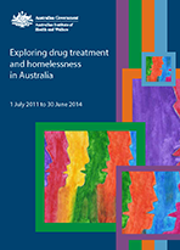Summary
There is much research to suggest a considerable overlap between people experiencing precarious housing, and those experiencing drug and alcohol misuse: many present both to alcohol and other drug treatment services (AODTS) with a variety of drug use issues, and to specialist homelessness services (SHS) either at risk of, or experiencing, homelessness. In an effort to better understand clients of both services, data from the Alcohol and Other Drug Treatment Services National Minimum Dataset (AODTS NMDS) and from the Specialist Homelessness Services Collection (SHSC) were linked for the period 2011–12 to 2013–14, allowing the identification of a 'matched client group' of around 40,000 clients—representing a significant proportion of AODTS (21%) and SHS (8%) clients.
This analysis examined the housing circumstances, treatment types, drugs of concern and service outcomes of matched clients and of their service populations (AODT-only and SHS- only populations). Within the matched client group, 4 cohorts were also examined: clients experiencing domestic and family violence; clients with a current mental health issue; young clients aged 15–24; and older clients aged 50 and over. Analysis of matched clients revealed:
- high levels of social and economic disadvantage—employment levels were lower than in the SHS-only population, at around 6% (compared with 13%). Over half of matched clients presented to SHS on their own and were more likely to be itinerant, suggesting that these clients are marginalised and without adequate support networks
- an over-representation of Aboriginal and Torres Strait Islander people—around 27% were Indigenous, compared with 22% of SHS-only and just 13% of AODT-only clients
- the majority were experiencing additional vulnerabilities—over 3 in 4 (77%) were experiencing an additional vulnerability and half (51%) presented with a current mental health issue
- the majority were male—almost 6 in 10 (59%) matched clients were male. However, for those experiencing domestic and family violence as well as seeking AOD treatment and SHS assistance, over 7 in 10 (73%) were female
- rates of treatment for heroin was double—treatment was higher among those experiencing precarious housing and homelessness than among the AODT-only population
- treatment for multiple drugs was significantly higher in the matched population—nearly 1 in 5 (18%) sought treatment for multiple drugs, nearly 3 times the rate of the AODT-only population
- over half the young people were homeless—young clients aged 15–24 were the most likely to present to SHS already homeless
- over two-thirds of older clients were in treatment for alcohol use—they also requested assistance for problematic alcohol use from SHS more than any other group
- they were less engaged with SHS—they tended to have more frequent periods of support yet fewer nights of accommodation, as clients with complex needs are more likely to 'churn' in and out of services (including short-term and emergency accommodation) with each crisis encountered
- all vulnerable cohorts had poorer AOD treatment and housing outcomes—compared with AODT-only and SHS-only populations.
Preliminary material: Acknowledgments; Abbreviations
1 Introduction
- How SHSC and AODTS data were matched
- Overview of key findings
2 Clients with a current mental health issue
- Client characteristics
- Why did these clients seek SHS assistance?
- Which drugs were they using?
- What services and support did they receive?
- What were the outcomes for clients?
- What does this tell us?
3 Clients who have experienced domestic and family violence
- Client characteristics
- Why did these clients seek SHS assistance?
- Which drugs were they using?
- What services and support did they receive?
- What were the outcomes for clients?
- What does this tell us?
4 Young clients 15-24 years
- Client characteristics
- Why did these clients seek SHS assistance?
- Which drugs were they using?
- What services and support did they receive?
- What were the outcomes for clients?
- What does this tell us?
5 Older clients 50 years and over
- Client characteristics
- Why did these clients seek SHS assistance?
- Which drugs were they using?
- What services and support did they receive?
- What are the outcomes for clients?
- What does this tell us?
Appendix A: Data linkage, data gaps and limitations
End matter: Glossary; References; List of tables; List of figures



